[GUIDE] How Long To Cook A 4lb Brisket In The Oven
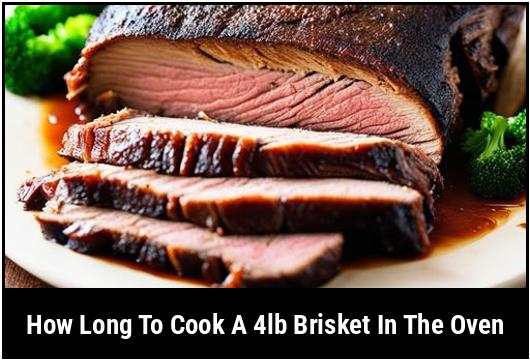
Cooking a brisket in the oven can be a wonderfully delicious and satisfying experience. However, achieving the perfect balance of tenderness and flavor requires careful cooking techniques and time management. In this article, we will explore the ideal cooking time for a 4lb brisket in the oven, along with valuable tips and tricks to ensure your brisket turns out tender, juicy, and full of flavor.
Quick Answer: How Long To Cook A 4lb Brisket In The Oven
If you are in a hurry and need a quick answer, a general guideline for cooking a 4lb brisket in the oven is around 4-5 hours at a low and slow temperature of 225°F (107°C). However, it is important to remember that cooking times can vary depending on the specific cut of brisket, the oven’s performance, and personal preferences.
Key Takeaways
- Cooking a 4lb brisket in the oven typically takes around 4-5 hours at 225°F.
- Ensure the internal temperature of the brisket reaches around 195-205°F for optimal tenderness.
- Use a meat thermometer to accurately monitor the internal temperature.
- Let the brisket rest for at least 15-20 minutes before slicing to lock in the juices.
- Experiment with different cooking techniques and variations to find your preferred flavor profile.
The Science Of Cooking Brisket

Before diving into the cooking process, let’s take a brief moment to understand the science behind cooking brisket. Brisket is a tough cut of meat from the lower chest area of the cow. It contains a high amount of connective tissue called collagen, which is responsible for its chewiness.
To transform a tough piece of brisket into a melt-in-your-mouth delicacy, the collagen needs to break down slowly and convert into gelatin. This process occurs at moderate temperatures over an extended period of time. The slow cooking method helps to tenderize the meat and infuse it with flavor from your chosen seasonings, rubs, and marinades.
Choosing Brisket
When it comes to selecting a brisket, it is essential to choose a quality cut of meat. Look for a well-marbled piece with a good balance of fat that is evenly distributed throughout the meat. Marbling is the dispersion of fine lines of fat throughout the muscle, contributing to tenderness and flavor.
One popular and widely available option is the packer brisket, which consists of both the flat and the point. The flat is leaner and usually preferred for slicing, while the point is fattier and ideal for shredding or making burnt ends. This cut provides an excellent balance of textures and flavors.
Preparing Brisket
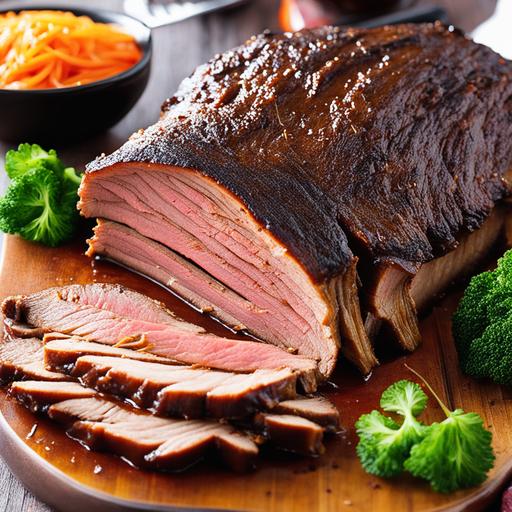
Properly preparing the brisket before cooking is crucial for achieving the best results. Here are some steps to follow:
-
Trim excess fat: While some fat is necessary to keep the brisket moist during cooking, excessive fat can lead to greasiness. Trim the fat cap to about 1/4 inch thickness, leaving a thin layer to provide flavor and protection.
-
Seasoning: Apply your chosen dry rub or marinade to enhance the flavor of the brisket. Allow the seasoning to penetrate the meat by applying it at least a few hours before cooking or even overnight in the refrigerator.
-
Bring to room temperature: Take the brisket out of the refrigerator and let it sit at room temperature for about 30-60 minutes before cooking. This helps to ensure even cooking throughout the meat.
Ideal Cooking Temperature For Brisket
Maintaining a consistent and low cooking temperature is essential for successful brisket cooking. A temperature of around 225°F (107°C) is ideal for allowing the collagen to break down slowly and achieve the desired tenderness.
Cooking the brisket at a high temperature may result in a tough and chewy outcome, whereas cooking at too low a temperature can prolong the cooking time unnecessarily. Use an oven thermometer to ensure accurate temperature readings throughout the cooking process.
Brisket Cooking Time

The cooking time for a 4lb brisket in the oven can vary depending on several factors, including the cut of brisket and how well your oven retains heat. As a general guideline, plan for approximately 1 hour of cooking time per pound of brisket at 225°F (107°C).
Therefore, a 4lb brisket would likely take around 4-5 hours. However, it is important to remember that everyone’s ovens and preferences differ. It is always better to use an instant-read meat thermometer to monitor the doneness of your brisket accurately.
Cooking Techniques
There are various cooking techniques you can employ to maximize the tenderness and flavor of your brisket. Here are a few popular ones:
-
Texas Crutch – This technique involves wrapping the brisket tightly in foil during the cooking process. This helps to retain moisture and speed up the cooking time. However, note that using the Texas Crutch may affect the formation of a crispy bark on the outside of the brisket.
-
Slow-Smoking – If you have a smoker, slow-smoking the brisket over wood chips or charcoal can add a delightful smoky flavor to the meat.
-
Drizzle with Liquid – To maintain moisture, you can periodically drizzle the brisket with a liquid of your choice, such as beef broth or apple juice. This technique helps to prevent drying out during the cooking process.
Monitoring And Troubleshooting
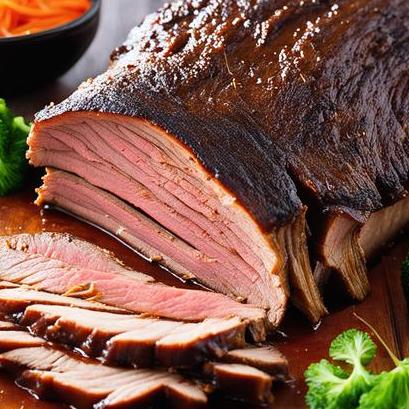
To ensure your brisket is cooked to perfection, monitoring the internal temperature throughout the cooking process is essential. Invest in a reliable meat thermometer and follow these guidelines:
-
Insert the thermometer probe into the thickest part of the brisket, making sure not to touch any bones.
-
Aim for an internal temperature of around 195-205°F (90-96°C) for optimal tenderness. At this temperature range, the collagen has converted into gelatin, resulting in a moist and tender brisket.
If your brisket is not reaching the desired temperature within the estimated cooking time, don’t panic. Each piece of meat is unique, and sometimes it may take longer than expected. Patience is key. Maintain the cooking temperature and continue cooking until the desired temperature is reached.
Brisket Cooking Instructions
To cook a 4lb brisket in the oven, follow these step-by-step instructions:
-
Preheat your oven to 225°F (107°C).
-
Trim excess fat from the brisket, leaving a thin layer to provide flavor and protection.
-
Apply your chosen dry rub or marinade to the brisket and let it sit at least a few hours or overnight in the refrigerator.
-
Take the brisket out of the refrigerator and allow it to come to room temperature for about 30-60 minutes.
-
Place the brisket on a rack inside a roasting pan or a baking dish.
-
Insert an oven-safe meat thermometer probe into the thickest part of the brisket.
-
Place the pan with the brisket in the preheated oven.
-
Cook for approximately 1 hour per pound of brisket, totaling around 4-5 hours for a 4lb brisket.
-
Monitor the internal temperature of the brisket using your meat thermometer.
-
When the internal temperature reaches around 195-205°F (90-96°C), remove the brisket from the oven.
-
Tent the brisket loosely with foil and allow it to rest for at least 15-20 minutes.
-
After resting, slice the brisket against the grain and serve.
Variations
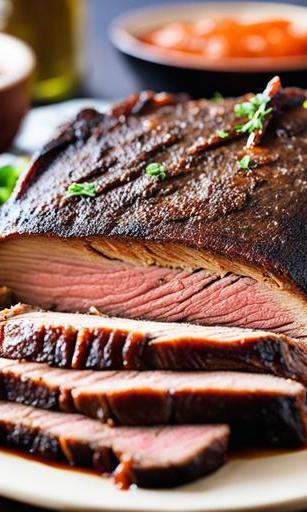
While the traditional method outlined above is a popular way to cook a 4lb brisket in the oven, there are several variations you can explore to add your own unique twist. Here are a few ideas:
-
Brisket Pot Roast: Braise the brisket in a savory broth with vegetables and herbs for a comforting pot roast-style brisket.
-
Barbecue Brisket: Brush the brisket with your favorite barbecue sauce during the last hour of cooking for a tangy and flavorful finish.
-
Asian-inspired Brisket: Marinate the brisket with soy sauce, ginger, garlic, and sesame oil for an Asian-inspired twist.
Feel free to experiment with different seasonings, spices, and cooking methods to create your signature brisket recipe.
When Things Go Wrong
Even the most experienced cooks encounter hurdles while cooking brisket. Here are a few common issues and how to troubleshoot them:
-
Tough Brisket: If your brisket turns out tough, it may not have cooked long enough. Continue cooking until the meat reaches the desired temperature and probe tenderness.
-
Dry Brisket: Overcooking or not properly sealing in moisture can result in a dry brisket. Ensure you wrap the brisket tightly in foil or use the Texas Crutch technique to retain moisture.
-
Uneven Cooking: If your brisket is unevenly cooked, it may be due to hot spots in your oven. Rotate the pan halfway through the cooking process or consider using a convection oven for more even heat distribution.
Remember that practice makes perfect. Don’t be discouraged by setbacks and keep experimenting to find the cooking method that works best for you.
Serving Brisket
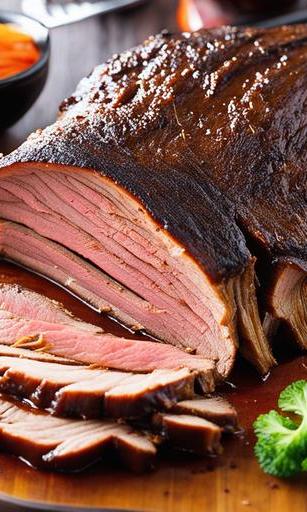
Once your tender and flavorful brisket is ready, it’s time to serve it up and enjoy. Here are a few serving suggestions to complement your delicious brisket:
-
Classic Sides: Serve your brisket with traditional side dishes like coleslaw, potato salad, cornbread, or baked beans.
-
Sandwiches: Slice the brisket and serve it on a soft bun with barbecue sauce for a mouthwatering brisket sandwich.
-
Tacos: Shred the brisket and serve it in warm tortillas with your favorite taco toppings for a Tex-Mex twist.
-
Plate Presentation: Arrange sliced brisket on a platter and garnish with fresh herbs or a sprinkle of smoked paprika for an elegant presentation.
Best Practices For Brisket Cooking
To ensure consistently delicious results with your brisket, here are some best practices to keep in mind:
-
Patience: Cooking brisket is a slow process that requires patience. Don’t rush it and give the meat enough time to become tender and flavorful.
-
Temperature Control: Monitor the cooking temperature carefully to maintain a steady 225°F (107°C) throughout the cooking process.
-
Resting: Allow the brisket to rest for at least 15-20 minutes after cooking to allow the juices to redistribute and the meat to relax.
-
Invest in a Meat Thermometer: Use an instant-read meat thermometer to ensure accurate temperature readings and avoid undercooking or overcooking.
Conclusion
Cooking a 4lb brisket in the oven can be a rewarding culinary adventure. By following the recommended cooking time of approximately 4-5 hours at 225°F (107°C), using proper techniques, and monitoring the internal temperature, you can achieve a perfectly tender and flavorful brisket.
Remember to experiment with seasonings, sauces, and cooking methods to create your own signature brisket recipe. With practice, patience, and attention to detail, you will be able to consistently impress your family and friends with a deliciously cooked brisket.
FAQS
What Is The Ideal Temperature To Cook A 4lb Brisket In The Oven?
The ideal temperature to cook a 4lb brisket in the oven is between 250 and 275°F.
How Long Should A 4lb Brisket Be Cooked In The Oven For Optimal Tenderness?
For optimal tenderness, a 4lb brisket should be cooked in the oven for 4-5 hours.
Should The Brisket Be Covered While Cooking In The Oven?
Yes, it is recommended to cover the brisket with aluminum foil or a lid to keep the moisture inside and prevent it from drying out.
How Often Should The Brisket Be Basted While Cooking In The Oven?
Basting the brisket every 30 minutes or so with a mixture of beef broth and spices will help it stay moist and flavorful throughout the cooking process.
Can A Meat Thermometer Be Used To Determine When The Brisket Is Fully Cooked In The Oven?
Yes, a meat thermometer can be used to determine when the brisket is fully cooked. The internal temperature of the brisket should reach 190-200°F for optimal tenderness.
Sources
About the Author Jenny
I'm Jenny, a housewife with an unwavering passion for food. My culinary journey began with my grandmother's kitchen, and it's now a full-fledged food blog. I've turned my love for cooking into a creative outlet, sharing recipes and stories with a global community of fellow food enthusiasts. It's proof that being a housewife can also mean pursuing your passions and savoring life's delectable moments.
